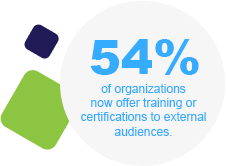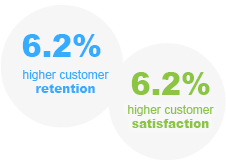WHAT YOU NEED,
TO SELL COURSES
ONLINE WITHOUT THE
TECH HEADACHES
You’re Sitting on a Training Goldmine.
You’ve spent years building your expertise.
Maybe you lead workshops. Run certification programs. Deliver training for clients, partners, or professional learners. People come to you because you know how to teach something that matters, something that helps them grow, qualify or succeed.

But here’s the question:
Are you making the most of that knowledge?
If you’re still delivering training one room at a time, or manually onboarding clients and logging certificates in a spreadsheet, there’s a better way. One that doesn’t require custom platforms, a whole dev team, or months of content production Today, more businesses, consultants and associations are turning their internal expertise into external revenue. And the best part? You don’t have to start from scratch.
This ebook will show you how to:
Turn the training you already deliver into a sellable online offering
Choose an eCommerce LMS that makes it easy to manage courses, payments, and learners
Reach more people, more efficiently, without losing the personal touch
Launch with confidence using what you already know
You already have the hard part, expertise, curriculum, credibility.
Now, let’s turn it into income, impact, and scalability.
Why Training
Is the New Product
Let’s start with a simple truth: You don’t need to invent a new product. You already have one. If you’ve created a course, taught a live class, or written a certification path, your knowledge is your product. And right now, there’s a growing demand for people who can teach clearly, credibly, and conveniently. We’re living in a moment where learning is no longer confined to classrooms or corporate intranets. People want self-paced, mobilefriendly, on-demand training and organizations are willing to pay for it. Not just for employees, but for customers, partners, franchisees, and association members too.
In fact, according to Brandon Hall Group:

That’s a number that’s rising steadily year over year. That means if you’re not already selling training, there’s a good chance your competitors will be.
From Expertise to Asset
The training you already deliver, whether it’s product onboarding, safety protocols, professional development, or compliance training can become a lasting asset:
• A recorded workshop becomes an evergreen course
• A live certification program becomes a scalable online academy
• A customer onboarding playbook becomes a branded learning path
• A one-on-one consultation becomes a self-paced training bundle
You don’t need to build a course empire. You just need an easy-to-use to use LMS platform that helps you share what you know, turn it into online courses and get paid for it. That’s where a cloud-based LMS with eCommerce functionality comes in.
With the right platform, you can:
• Create courses using your existing materials
• Set pricing, issue certificates and track engagement
• Launch a polished, professional learning storefront, without custom coding
In the next section, we’ll explore the most common (and profitable) ways businesses are selling their training online and how you can start with what you already have.
Top Use Cases for Selling Training.
You don’t have to invent a reason to sell training. The demand is already there.
Every day, people search for ways to get certified, onboard faster, meet regulatory requirements, or improve their skills. The question is: will they find your content or someone else’s? Whether you’re a training company, association, consultant, or internal L&D leader exploring external monetization, here are the most common (and profitable) ways organizations are already turning their training into revenue.
1. Certification Prep & Licensing Programs
From real estate and finance to healthcare and HR, learners are seeking ways to get licensed and stay licensed. If you already offer prep courses or continuing education, turning them into an online, self-paced format can reduce delivery costs and dramatically expand your reach.
Example: A real estate school digitizes its live exam prep curriculum and sells on-demand access to agents statewide, earning revenue 24/7 without increasing staff hours.

2. Compliance Training & for Customers or Partners
Every day, people search for ways to get certified, onboard faster, meet regulatory requirements, or improve their skills. The question is: will they find your content or someone else’s? Whether you’re a training company, association, consultant, or internal L&D leader exploring external monetization, here are the most common (and profitable) ways organizations are already turning their training into revenue.
Example: A real estate school digitizes its live exam prep curriculum and sells on-demand access to agents statewide, earning revenue 24/7 without increasing staff hours.

3. Continuing Education and CEU Credits
Associations and professional bodies are already trusted sources for industry knowledge. Offering CEU-eligible training online gives members year-round access to development while giving you a new stream of recurring revenue.
Example: A healthcare association launches an online CEU hub, selling accredited courses to members with instant certificate downloads.

4. Product Training and Customer Education
Don’t just send your customers
a user manual. Show them how
to succeed with you on their
schedule. Customer education
reduces churn, boosts
satisfaction and creates a
value-add service offering that
can be packaged as a premium
add-on.
Stat Spotlight
According to Talented Learning, companies with mature customer education programs see:

5. Partner, Resellert, and Channel Enablemen
If your business relies on external sellers or distributors, training them well and consistently is the key to success. By selling or licensing online training to your partners, you not only increase product knowledge, but also standardize brand messaging and reduce support friction.
Example: A software company offers its global reseller network a tiered training and certification program, bundled with marketing materials and onboarding tools.

What to Look for in an eCommerce-Ready LMS.
Picture this: You’ve finally put your course together.
It’s built on the same training you’ve delivered in person for years, and it’s ready for the world. Now, you just need a way to get it online, offer it for sale and make sure your learners actually complete it.

So you start looking at learning platforms. But what you find is... underwhelming.
Most learning management systems were designed for HR departments. They’re great at tracking employee compliance and assigning internal policies. But they weren’t built to sell training. They weren’t built for you. That’s why choosing an eCommerce LMS is so important. If you’re serious about monetizing your knowledge, you need a platform that doesn’t just deliver content. It helps you run a training business. Here’s what that looks like.
A Shopping Experience That Feels Like… Shopping
When someone lands on your course page, they shouldn’t be confused or overwhelmed.
They should feel like they’re browsing a clean, modern online store.
Look for a platform that gives you:
• A searchable, filterable course catalog
• Categories and tags for organizing by topic or certification type
• A mobile-friendly layout that works just as well on a phone as a laptop
Your LMS should feel more like Shopify than a company intranet.
Payments That Work
This might sound obvious, but some platforms still require third-party plugins or manual
invoicing. That’s friction you don’t need.
Make sure your LMS includes:
• Built-in Stripe or PayPal integration
• Coupon codes and discounts for promotions
• Auto-enrollment after payment with no manual steps
Because if someone’s ready to buy your training at 2 a.m. from their phone, your platform should
be ready too.
Instant Access, Set It and Move On
You shouldn’t have to manage every learner by hand. With the right SaaS LMS, enrollment
should be instant, secure and hands-off.
Look for features like:
• Automatic course access upon purchase
• Timed access windows or content expiration
• Group purchasing and team licenses for B2B buyers
Whether you’re selling to individual learners or entire teams, enrollment should be smooth for
both them and for you.
Certification That Builds Credibility
One of the best ways to increase the perceived value of your course? Offer a branded
certificate. Whether it’s for compliance, CEUs or professional branding, certification shows
learners and their employers that the training means something.
A great LMS platform will let you:
• Automatically generate certificates upon completion
• Include your logo and custom language
• Track who’s certified and when they need to recertify
For industries like healthcare, finance, or construction, certification isn’t optional it’s expected.
Reporting That Actually Tells You Something
You’re not just a course creator. You’re a business owner. That means you need data.
Find a platform that gives you:
• Revenue and sales reports by course or time period
• Completion and engagement metrics
• Insight into your best-performing courses and learners
You shouldn’t have to guess what’s working, you should be able to prove it.
Branding, Flexibility, and Room to Grow
Your LMS should look and feel like you, not the vendor behind it.
That’s why it should offer:
• Custom branding (colors, logos, domains)
• White-labeling options if you serve clients or associations
• Support for SCORM/xAPI content, video, quizzes and interactive media
• Optional add-ons like QR code verification or social certificate sharing
If you’re planning to scale, or already training multiple audiences, look for extended enterprise
LMS features, which let you train employees, customers, partners and resellers all from the
same hub.
The Bottom Line
The best learning management system isn’t the one with the most buttons. It’s the one that makes selling your training easy. When your LMS does the heavy lifting payments, enrollments, certificates, tracking so you get to focus on what you do best: creating content that delivers real value. Next up: how to launch your training business using the materials you already have.
Stat Spotlight
According to eLearning Industry,
In other words, your audience is ready for self-paced eCommerce training. You just need the right platform to deliver it.
Don’t Start from Scratch. Use What You Have.
One of the biggest myths about selling online training is
that you have to build everything from the ground up.
But here’s the truth: you already have more than enough to get started.
Think about it:
• That live workshop you’ve delivered a dozen times? That’s a
course.
• The slide deck you use in new hire training? That’s your
module outline.
• The SOPs, Zoom recordings, worksheets, or quizzes you’ve
built over the years? That’s your course content.
The difference between internal training materials and a paid
online course is structure, polish and delivery. Not reinvention.
Let’s walk through how to take what you’ve already created and
turn it into a polished, sellable learning experience.

STEP 1: Inventory What You Already Teach
Start by taking stock of your existing assets:
• Slide decks
• Recorded webinars or presentations
• Handouts, ebooks, or internal manuals
• Live training outlines or checklists
Assessments or quiz questions If it’s helped someone learn something, even once, it’s a potential building block.
STEP 2: Use Built-In LMS Tools to Assemble It
A modern cloud-based LMS makes it easy to upload and organize
your content, no instructional design degree required.
You can:
• Upload PDFs, video files and presentations
• Add narration, section titles and knowledge checks
• Drag and drop to create a logical, self-paced flow
• Set prerequisites or progress gates if needed
Many SaaS LMS platforms include native content authoring tools,
so you don’t need additional software. Just bring your materials and
start assembling.
STEP 3: Test with a Pilot Group
You don’t need to launch to hundreds right away. Start with a beta
group. Former clients, trusted peers, or existing users who can
provide feedback.
Watch where they get stuck. Ask what they found valuable. Iterate
quickly.
You can even offer early access at a discount in exchange for
testimonials or reviews adding social proof to your online training
business right from the start.
STEP 4: Repurpose and Repackage
Once you’ve built one course, you’ll start seeing new
opportunities:
• Break a longer course into shorter modules and sell as a
bundle
• Offer a foundational course and upsell advanced versions
• Use snippets of your content as lead magnets or free trials
Your LMS platform becomes the engine that turns knowledge into
revenue and gives you the flexibility to evolve your training library
over time easily.
The Bottom Line
You don’t need a film crew. You don’t need a curriculum designer. You don’t need six months. You need a starting point and the right platform to help you turn that starting point into a structured, scalable, online course offering. In the next section, we’ll cover how to market and sell your training like a business, not just a product, so your content gets seen (and purchased) by the right people.
Real Talk:
Don’t wait until your course is “perfect.” Launch with what’s valuable, not what’s polished. You can refine over time, especially once you see what people are willing to pay for.
Market and Sell Like a Training Business
You’ve got a course. You’ve got a platform. Now comes the part that stops many would-be training entrepreneurs in their tracks: marketing.
Don’t worry, you don’t need to become a full-time marketer or hire an agency to sell your online training. What you need is a simple, repeatable way to get your course in front of the right people, demonstrate its value, and encourage them toward enrollment. Let’s talk about how to do that, without burning yourself out or blowing your budget.

Build a Storefront, Not Just a Link
If you’re asking people to pay for training, your course experience should
feel as professional as the knowledge inside it.
That means:
• A branded catalog or landing page
• Course titles and descriptions that focus on outcomes, not features
• Clear pricing and purchasing steps
• Trust elements like instructor bios, testimonials, and preview videos
Your LMS should support this natively or integrate easily with your
website, so you’re not duct-taping together five tools just to get a “Buy
Now” button to work.
Use Email and Lead Magnets to Fill the Funnel
People don’t always buy the first time they see your course. That’s normal.
That’s why your marketing strategy should include:
• A free resource (checklist, video, or mini-course) to attract leads
• A lead capture form connected to your email platform
• A simple welcome sequence that educates and builds trust
• Ongoing emails with tips, use cases, and success stories
These small touches help warm up your audience so that when they’re ready, they’re choosing you.

Add Value with Certifications and Badges
If you’re asking people to pay for training, your course experience should
feel as professional as the knowledge inside it.
That means:
• A branded catalog or landing page
• Course titles and descriptions that focus on outcomes, not features
• Clear pricing and purchasing steps
• Trust elements like instructor bios, testimonials, and preview videos
Your LMS should support this natively or integrate easily with your
website, so you’re not duct-taping together five tools just to get a “Buy
Now” button to work.
Use Email and Lead Magnets to Fill the Funnel
Here’s a powerful marketing tip: completion is easier to sell than access.
In other words, people aren’t buying your content, they’re buying what it will do for them.
When your LMS includes:
• Certificates of completion
• CEU tracking
• Shareable badges (LinkedIn, email signatures, resumes)
You’re giving learners something tangible they can use to demonstrate growth. That makes your
training more valuable and justifies a higher price point.
Stat Spotlight
According to Lighthouse
Research & Advisory,
adding certification increases
course completion rates by:

30%
and drives higher learner satisfaction.

Sell to Teams, Not Just Individuals
One of the most overlooked opportunities in online training is B2B sales.
You don’t have to rely on single sign-ups when you can:
• Offer bulk pricing for teams
• Allow one buyer to assign licenses to multiple learners
• Customize packages for partners, franchises, or corporate accounts
Look for an LMS that makes group licensing easy to manage, so you can
sell once and serve many.
Promote with Purpose
You don’t need to be on every channel. Focus on where your ideal learners already spend
their time.
That could mean:
• Running webinars or guest sessions with industry associations
• Promoting on LinkedIn if your audience is professional or credentialed
• Encouraging happy customers to refer others
• Offering a discount for first-time buyers or bundle upgrades
Your best marketing asset might be your learners themselves. Encourage testimonials,
course reviews, and word-of-mouth. The more success stories you collect, the easier it gets
to attract more.
The Bottom Line
You don’t need a film crew. You don’t need a curriculum designer. You don’t need six months. You need a starting point and the right platform to help you turn that starting point into a structured, scalable, online course offering. In the next section, we’ll cover how to market and sell your training like a business, not just a product, so your content gets seen (and purchased) by the right people.
Pricing Models
That Scale.
You’ve done the hard part. You’ve created your course, chosen your platform and built a path to market it. Now comes a deceptively simple question:

What should you charge?
Pricing online training can feel like a shot in the dark, especially if you’re used to giving it away as part of a broader service. But the right pricing model doesn’t just help you make money. It helps your learners see the value of what you’re offering. Let’s walk through the most common pricing models for selling training, and how to choose the one that supports both your business goals and your audience’s needs.
One-Time Purchase
This is the simplest model and a great place to start. Learners pay once for lifetime or limited-time access.
Best for:
• Standalone certification or prep courses
• Continuing education units (CEUs)
• Niche professional training programs
You can always sweeten the deal by offering:
• Bundles (buy 3, get 1 free)
• Limited-time discounts
• Bonus content for early access

Subscription Access
In this model, learners pay monthly or annually to access a library of courses.
Best for:
• Ongoing skills development
• Compliance or safety training that requires frequent refreshers
• Professional communities or associations
Subscription access builds recurring revenue and encourages course creators to add value
continually. Just make sure your LMS supports auto-renewals, access controls, and content drip options.
Group Licensing
This is where things get exciting, especially for B2B sales. Group licensing allows
companies or teams to buy access for multiple learners at once, often at a discounted rate.
Best for:
• Selling to franchises, partner networks, or corporate clients
• Certification training with team-wide requirements
• Customer onboarding for SaaS or service businesses
Look for LMS features that let one buyer assign licenses, track learner progress and manage
team billing.
Free + Paid Upsell (Freemium Model)
Want to build an audience fast? Offer a free intro course, checklist, or mini-training to build
trust, then upsell access to a full certification path or advanced modules.
Best for:
• Subject matter experts launching their first course
• Driving leads for consulting or coaching services
• Building a long-term funnel for membership programs
Pair this model with email automation inside your LMS or CRM so your upsell happens
automatically after a learner completes a free course.
The Bottom Line
You don’t need a film crew. You don’t need a curriculum designer. You don’t need six months. You need a starting point and the right platform to help you turn that starting point into a structured, scalable, online course offering. In the next section, we’ll cover how to market and sell your training like a business, not just a product, so your content gets seen (and purchased) by the right people.
Pro tip:
Test pricing early and often. Start with a beta launch at a reduced rate, collect testimonials, then gradually increase pricing as social proof and demand grow.
Bonus section:
Serving Associations,
CEU Programs and
Credentialing Bodies.
If you’re part of a membership organization, trade association, or licensing body you’re in a unique position.

You don’t just educate, you validate. You don’t just deliver content, you provide proof.
That makes your training incredibly valuable, but also uniquelycomplex. You’re not just selling learning. You’re delivering trust,compliance, and credibility, often at scale. This section is your playbook for using an LMS to serve
professional learners who need continuing education units
(CEUs), certifications, or credentials and who expect a
seamless, authoritative experience.
Deliver CEUs That Are Easy to Earn and Easy to Track
CEU-eligible courses come with requirements like time tracking, assessments and proof of
completion. A modern learning management system should handle all of this automatically.
Look for features like:
• Completion certificates with CEU values preloaded
• Timed content delivery (so learners can’t skip ahead)
• Built-in quizzes or final assessments
• Admin dashboards to verify completion and issue records
You should be able to pull reports instantly for audits, accreditors or internal tracking without
accessing spreadsheets.
Stat Spotlight
According to Lighthouse
Research & Advisory,
44%

of organizations offering CEUs say automated tracking is their biggest challenge and their top reason for switching LMS platforms.
Streamline Certification and Recertification
Many associations run not only training, but full certification programs, with expiration
windows, re-enrollment cycles, and membership status tied to completion.
Your LMS should allow you to:
• Set course expiration or recertification reminders
• Offer tiered or stacked credentials
• Provide re-enrollment paths without manual admin work
• Track and archive credentials over multiple years
This is especially important if your learners need to show credentials to employers, licensing
boards, or insurers.
Monetize Training While Delivering Member Value
Associations have a built-in audience, but that doesn’t mean you should give everything away
for free. In fact, paid training is one of the most sustainable revenue sources for associations.
Your LMS should support:
• Member-only pricing tiers
• Group discounts for corporate members
• Bundled CEU packages or certification prep kits
• Affiliate tracking for partner promotion
Whether you’re selling to individuals or entire companies, make it easy to buy, easy to assign,
and easy to renew.both them and for you.
Payments That Work
This might sound obvious, but some platforms still require third-party plugins or manual
invoicing. That’s friction you don’t need.
Make sure your LMS includes:
• Built-in Stripe or PayPal integration
• Coupon codes and discounts for promotions
• Auto-enrollment after payment with no manual steps
Because if someone’s ready to buy your training at 2 a.m. from their phone, your platform should
be ready too.
Instant Access, Set It and Forget It
You shouldn’t have to manage every learner by hand. With the right SaaS LMS, enrollment
should be instant, secure and hands-off.
Look for features like:
• Automatic course access upon purchase
• Timed access windows or content expiration
• Group purchasing and team licenses for B2B buyers
Whether you’re selling to individual learners or entire teams, enrollment should be smooth for
both them and for you.
Certification That Builds Credibility
One of the best ways to increase the perceived value of your course? Offer a branded
certificate.
Whether it’s for compliance, CEUs or professional branding, certification shows learners and
their employers that the training means something.
A great LMS platform will let you:
• Automatically generate certificates upon completion
• Include your logo and custom language
• Track who’s certified and when they need to recertify
For industries like healthcare, finance, or construction, certification isn’t optional it’s expected.
The Bottom Line
You don’t need a film crew. You don’t need a curriculum designer. You don’t need six months. You need a starting point and the right platform to help you turn that starting point into a structured, scalable, online course offering. In the next section, we’ll cover how to market and sell your training like a business, not just a product, so your content gets seen (and purchased) by the right people.
Executive Summary:
Your Knowledge Is
More Valuable Than
You Think.
You don’t need to start from scratch. You don’t need a huge team. And you certainly don’t need a custom-built training platform.
What you need is a clear path, the right tools and the confidence to
turn your expertise into a scalable, sellable online training program.
This ebook has shown you how to do exactly that.
Key Takeaways
• You already have the content, it just needs to be packaged and delivered online.
• eCommerce-ready LMS platforms make it easy to sell, certify and scale your training without complex tech.
• You can start small by repurposing existing training materials and launching with a pilot group.
• Smart pricing and marketing help you build recurring revenue, whether you’re serving individuals, teams or organizations.
• Certifications, CEUs, and compliance training are high-value offerings that people are actively looking for and willing to pay for.
• Associations, consultants, and training companies are leading the way by using LMS platforms to turn education into income.
Whether you’re teaching real estate agents, training medical staff, supporting software
customers, or educating franchise partners, your learning program can (and should)
become a revenue-generating part of your business.
Ready to Launch?
The difference between an idea and a thriving training business is action.
If you’re ready to:
• Sell training courses online
• Issue certificates and track learner progress
• Offer CEUs or compliance paths to external audiences
• Build a branded, professional course catalog
• Reach more learners without more manual work
…then it’s time to choose an LMS built for that purpose.

DigitalChalk helps organizations turn knowledge into income with the tools, structure,and support you need to launch and grow. Let’s turn your training into a revenue stream that scales with you.
